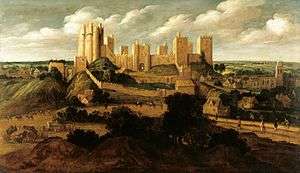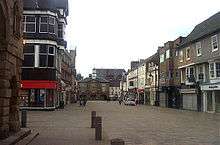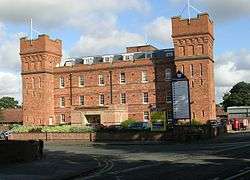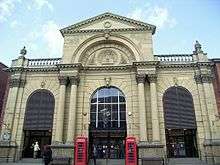Pontefract
| Pontefract | |
 Old Town Hall (1745) |
|
 Pontefract |
|
| Population | 30,881 (North+South Wards 2011) |
|---|---|
| OS grid reference | SE455215 |
| Metropolitan borough | City of Wakefield |
| Metropolitan county | West Yorkshire |
| Region | Yorkshire and the Humber |
| Country | England |
| Sovereign state | United Kingdom |
| Post town | PONTEFRACT |
| Postcode district | WF8 |
| Dialling code | 01977 |
| Police | West Yorkshire |
| Fire | West Yorkshire |
| Ambulance | Yorkshire |
| EU Parliament | Yorkshire and the Humber |
| UK Parliament | Normanton, Pontefract and Castleford |
Coordinates: 53°41′28″N 1°18′43″W / 53.691°N 1.312°W
Pontefract is a historic market town in West Yorkshire, England, near the A1 (or Great North Road) and the M62 motorway. Historically part of the West Riding of Yorkshire, it is one of the five towns in the metropolitan borough of the City of Wakefield and has a population of 28,250,[1] increasing to 30,881 at the 2011 Census.[2][3] Pontefract's motto is Post mortem patris pro filio, Latin for "After the death of the father, support the son", a reference to English Civil War Royalist sympathies.[4]
Origins of the name 'Pontefract'
At the end of the 11th century, the modern township of Pontefract consisted of two distinct and separate localities known as Tanshelf and Kirkby.[5] The 11th century historian, Orderic Vitalis, recorded that, in 1069, William the Conqueror travelled across Yorkshire to put down an uprising which had sacked York, but that, upon his journey to the city, he discovered that the crossing of the River Aire at what is modern-day Pontefract had been blockaded by a group of local Anglo-Scandinavian insurgents, who had broken the bridge and held the opposite bank in force.[6] Such a crossing point would have been important in the town's early days, providing access between Pontefract and other settlements to the north and east, such as York.[7] Historians believe that, in all probability, it is this historical event which gives the township of Pontefract its modern name. The name "Pontefract" originates from the Latin for "broken bridge", formed of the elements pons ('bridge') and fractus ('broken'). Pontefract was not recorded in the 1086 Domesday Book, but it was noted as Pontefracto in 1090, four years after the Domesday survey.[8]
History
Neolithic
In 2007 a suspected extension of Ferrybridge Henge – a Neolithic henge – was discovered near Pontefract during a survey in preparation for the construction of a row of houses. Once the survey was complete, the construction continued.[9]
Roman
The modern town is situated on an old Roman road (now the A639), described as the "Roman Ridge", which passes south towards Doncaster. The Roman Ridge is believed to form part of an alternative route from Doncaster to York via Castleford and Tadcaster, as a diversion of the major Roman road Ermine Street, which may have been used to avoid having to cross the River Humber near North Ferriby during rough weather conditions over the Humber.
Anglo-Scandinavian history
The period of Yorkshire's history between the demise of the Viking king Eric Bloodaxe in 954 and the arrival of the Normans in 1068 is known as the Anglo-Scandinavian age. The modern township of Pontefract consisted of two Anglo-Scandinavian settlements, known as Tanshelf and Kirkby. In Yorkshire, place-name locations often contain the distinctive Danish '-by' i.e. Kirkby. And even today, the major streets in Pontefract are designated by the Danish word 'gate' e.g. Bailygate.
Tanshelf and Kirkby
The Anglo-Scandinavian township of Tanshelf recorded variously as Tateshale, Tateshalla, Tateshalle or Tatessella in the 1086 Domesday Book existed in the region that is today occupied by the town of Pontefract. The Anglo-Saxon Chronicle makes its first reference to Tanshelf in the year 947 when King Eadred of England met with the ruling council of Northumbria to accept its submission. King Eadred did not enjoy Northumbria's support for long, and a year later the kingdom voted Eric Bloodaxe King of York.[10]
When the Doomsday Book was commissioned by William the Conqueror in 1086 Tanshelf was still a sizeable settlement for the period. The town had a priest, 60 petty burgesses, 16 cottagers, 16 villagers and 8 smallholders, amounting to a total of 101 people. But the actual size of the population might be as much as four or five times larger than this as the people listed are landholders, and therefore the Doomsday Book does not take their families into account. Tanshelf also had a church, a fishery and three mills. Archaeologists have discovered the remains of the church on The Booths in Pontefract, off North Baileygate, below the castle. The oldest grave dates from around 690. The church is likely to be at Tanshelf and may have been similar to the church at Ledsham. The area which is now the town market place was the original meeting place of the Osgoldcross wapentake.[11] In the Anglo-Saxon period a part of the modern township of Pontefract was known by the Anglo-Scandinavian name of Kirkby.
Medieval
Norman conquest

After the Norman conquest in 1066 almost all of Yorkshire came under the ownership of followers of William the Conqueror,[12] one of whom was Ilbert de Lacy who became the owner of Tateshale (Tanshelf) where he began to build a castle.[12] Pontefract Castle began as a wooden motte and bailey castle, built before 1086 and later rebuilt in stone. The de Lacys lived in the castle for more than two centuries[13] and were holders of the castle and the Honour of Pontefract from 1067[14] until the death of Alice de Lacy in 1348.[15]
King Richard II was murdered at the castle in 1400.[16][17] Little is known of the precise nature of his demise; in particular Shakespeare may have "adjusted" the facts for his own purposes.[18] There are at least three theories which attempt to explain his death:[19] He was starved to death by his keepers, he starved himself to death or he was murdered by Sir Piers (Peter) Exton on 14 February 1399 or 1400.[20]
Robin Hood
Fifteenth century Robin Hood ballads place the outlaw's activities in the forest of Barnsdale, the southern edge of which borders Pontefract. In particular, the medieval ballads make specific reference to the village of Wentbridge, which is an outlying village of the modern town of Pontefract.[21] In addition, Michael Drayton's Poly-Olbion Song 28 (67–70) composed in 1622 speaks of Robin Hood's death and clearly states that the outlaw died at Saxon 'Kirkby', modern Pontefract.[22] The historian S. A. La' Chance proposes that Robin Hood died at Saint Nicholas's hospital, Kirkby, which was attached to All Saints' Church.[23] In commemoration of Wakefield's connections to Robin Hood, a plaque has been placed on the bridge that crosses the River Went.
Early modern history
Tudor
In Elizabethan times the castle, and Pontefract itself, was referred to as "Pomfret".[16] William Shakespeare's play Richard III mentions the castle:
- Pomfret, Pomfret! O thou bloody prison,
- Fatal and ominous to noble peers!
- Within the guilty closure of thy walls
- Richard the second here was hack'd to death;
- And, for more slander to thy dismal seat,
- We give thee up our guiltless blood to drink.[16]
Pomfret is referred to also in "Richard II" (V, 1, 52).
Civil war

Pontefract suffered throughout the English Civil War. In 1648–49 the castle was laid under siege by Oliver Cromwell, who said it was "... one of the strongest inland garrisons in the kingdom."[16] Three sieges by the Parliamentarians left the town "impoverished and depopulated".[24] In March 1649, after the third siege, Pontefract inhabitants, fearing a fourth, petitioned Parliament for the castle to be slighted.[24] In their view, the castle was a magnet for trouble,[24] and in April 1649 demolition began.[24] As of 2014 the ruins of the castle remain and are publicly accessible.
Pontefract Priory history
Pontefract was the site of Pontefract Priory, a Cluniac priory founded in 1090 by Robert de Lacy dedicated to St John the Evangelist. The priory was dissolved by royal authority in 1539. The abbey maintained the Chartularies of St John, a collection of historic documents later discovered among family papers by Thomas Levett, the High Sheriff of Rutland and a native of Yorkshire, who later gave them to Roger Dodsworth, an antiquary.[25] They were later published by the Yorkshire Archaeological Society.
Pontefract today




Pontefract has been a market town since the Middle Ages; market days are Wednesday and Saturday, with a smaller market on Fridays. The covered market is open all week, except Thursday afternoons and Sundays. Thursday afternoon is half-day closing in the town. The town is called 'Ponte'/'Ponty' by its citizens and sometimes jokingly referred to as Ponte Carlo, in reference to Monte Carlo. This theme is continued in the name of bars in the xscape complex, Glasshoughton between Pontefract and Castleford, referred to locally as 'Cas Vegas'. It is reported that Pontefract once held the British record for the town with the most pubs per square mile: indeed, numerous pubs still survive in the town centre in particular, for example Beastfair Vaults, the Liquorice Bush, the Red Lion, the Malt Shovel and the Blackmoor Head. A Wetherspoon public house opened on Horsefair in 2010.
Pontefract's deep, sandy soil makes it one of the few British places in which liquorice can successfully be grown. The town has a liquorice-sweet industry; and the famous Pontefract Cakes are produced, though the liquorice plant itself is no longer grown there. The town's two liquorice factories are owned by Haribo (formerly known as Dunhills) and Tangerine Confectionery (formerly part of the Cadbury's Group as Monkhill Confectionery, and before that Wilkinson's), respectively. A Liquorice Festival is held annually. Poet laureate Sir John Betjeman wrote a poem entitled "The Licorice Fields at Pontefract". In 2012 local farmer Robert Copley announced that he would be re-introducing a liquorice crop to Pontefract.[26][27]
Close by is the coal-fired power station at Ferrybridge, although the local coal mines largely closed in the 1990s, contributing to high unemployment in the local area. The final colliery, Prince of Wales Colliery, closed in 2002.[28]
There are a number of supermarkets in Pontefract which include a Tesco and Morrisons which are located opposite each other, and an Asda, which was originally a Kwik Save store, a short distance outside the town centre. The secondary schools in the town are Carleton Community High School in Carleton, and the King's School on Mill Hill Lane, both for pupils aged 11–16. A sixth-form college, NEW College Pontefract, is located on Park Lane.
The old Pontefract General Infirmary on Southgate (pictured) was a general hospital; it is the place at which serial killer Harold Shipman began to murder his elderly patients. Beneath this building is an old hermitage, open to the public on certain days. Pontefract Museum, from which the hermitage schedule can be obtained, is in the town centre, housed in the former Carnegie library. (A new hospital was built on Friarwood and opened in 2010 with the new name of Pontefract Hospital and there is now a modern library building.) Pontefract has three railway stations: Pontefract Baghill, on the Dearne Valley Line, which connects York and Sheffield; and Pontefract Monkhill and Pontefract Tanshelf, which connects with Leeds and Wakefield. There are also rail services from Bradford to London that stop at Pontefract Monkhill.
The local police force is West Yorkshire Police, with the town's neighbourhood policing team being situated at the new fire station on Stumpcross Lane. The original police station situated in Sessions House yard is due for closure since the new divisional headquarters for the Wakefield District opened in Normanton and the neighbouring magistrates' court has moved over to Wakefield.
Fire cover is provided by West Yorkshire Fire and Rescue with one pump (sometimes two) based at Pontefract Fire Station. Formerly located on Stuart Road in the town centre, the station has now moved to a new site at Stumpcross Lane, by the A645 road at the town's eastern edge. The new fire station also provides cover for Knottingley, that town's fire station having been closed as part of the merging of fire cover for Pontefract and Knottingley.
The Territorial Army, Army Cadets and Air Training Corps all have a presence within the town and are based at the historic Pontefract Barracks building on Wakefield Road. It now houses a Rifles Regiment Recruitment team.
Media, arts and entertainment
The local newspaper is the Pontefract and Castleford Express. Pontefract is known for its 'down-to-earth' nightlife.[29] Venues include Big Fellas, the Elephant, the Green Dragon, the Tap and Barrel, Wetherspoons, the Malt Shovel, and the Blackmoor Head. In September 2012 one of Pontefract's old Nightclubs, Kiko's, re-opened its doors to the public after being closed for many years.
Novelist Jack Vance, in the "Demon Princes" cycle has named the capital of Aloysius, the main planet in the Vega system after Pontefract. The hero of the series, Kirth Gersen, has his residence there.
Ridings FM is the town's local commercial radio station, Launched in October 1999, Ridings FM can be heard across Pontefract on 106.8 FM. The station serves the wider Wakefield District. The station has a close relationship with the community and is actively involved in local charities fundraising efforts.
Governance
For local government purposes the town lies in the City of Wakefield, coming under the governance of Wakefield Council. For this purpose it is divided into two electoral wards, Pontefract North and Pontefract South. Pontefract South is currently represented by three Labour councillors with North ward represented by three Labour councillors [as of September 2015].[30] South ward is a marginal ward, containing relatively affluent suburbs of Pontefract and outlying villages such as Darrington, combined with less wealthy areas such as Chequerfield, whilst North Ward includes parts of Monkhill, Ladybalk and Myson Chair.
From 1978 to 1997 the local ex-miner and former local NUM branch leader Geoff Lofthouse (18 December 1925 – 1 November 2012) was MP for the former constituency of Pontefract and Castleford. During this time he rose to the position of Deputy Speaker of the House of Commons. When the general election of 1997 was called he stood down to allow Yvette Cooper to be selected as the Labour Party candidate for that election. He was made a peer on 11 June 1997.
Yvette Cooper MP, was elected MP for the Pontefract and Castleford constituency at the 1997 general election. Cooper held a number of positions in the Labour governments up to 2010, followed by Shadow Cabinet roles after the election of that year, but returned to the back benches following the Labour leadership election of 2015. Pontefract and Castleford was merged with the Normanton constituency in a boundary change before the 2010 general election.
In her maiden speech to the House of Commons, Cooper said:
It is true that my constituency is plagued by unemployment, but I represent hard-working people who are proud of their strong communities and who have fought hard across generations to defend them. They are proud of their socialist traditions, and have fought for a better future for their children and their grandchildren. In the Middle Ages, that early egalitarian, the real Robin Hood, lived, so we maintain, in the Vale of Wentbridge to the south of Pontefract. It was a great base from which to hassle the travelling fat cats on the Great North Road.
The seat, which has a history of mining and industry, has consistently returned Labour MPs at general elections. Yvette Cooper polled 48.1% of the vote in the 2010 general election.
Sports
The town is home to many sports including cricket, football and squash. Prominent squash players Lee Beachill and James Willstrop both train at Pontefract Squash Centre. Notable institutions are horse racing at Pontefract Racecourse and Featherstone Rovers, the area's professional rugby league club.
Pontefract Racecourse is the longest continuous horse racing circuit in Europe at 2 miles 125 yards (3,333 m; 16.57 furlongs).[31] It stages flat racing between the end of March and the end of October. Nearer to the town centre are the Valley Gardens, with a love garden, an aviary, and an avenue of cherry trees, which bloom in the spring. Although the trees continue to attract admiration, the gardens have become quite depleted and the aviary has been vandalised. Pontefract swimming pool is on Stuart Road.
Pontefract has its own non-league football club, Pontefract Collieries F.C., which was founded in 1958 and plays adjacent to the former Prince of Wales Colliery off Beechnut Lane. The team, known locally as "Ponte Colls" play in the Northern Counties East Football League Pontefract is also home to the Pontefract Knights rugby league football club.
Pontefract RUFC is based at Moor Lane Carleton. It runs three senior sides as well as a number of junior and girls teams. Rugby Union has been played in the town since the 19th Century when Pontefract won the Yorkshire Cup.
Notable people
- Thurstan of Bayeux, (c.1017–1140) Archbishop, died at Pontefract.
- Richard de Pontefract (?–1320?), Dominican friar King Edward II.
- John Ramsden (1594–1646), High Sheriff of Yorkshire, MP for Pontefract in the Short Parliament, and Royalist soldier.
- John Jackson (1595?–1637), MP for Pontefract during the Happy Parliament.
- Francis Drake (1696–1771), antiquary and surgeon.
- Robert Monckton, (1726–1782), MP for Pontefract and British army general.
- John Smyth (1748–1811), MP for Pontefract.
- Jesse Hartley (1780-1860) Civil Engineer and Superintendent of the Concerns of the Dock Estate, Liverpool. Built the Albert Dock and many other parts of Liverpool Docks.
- Charles Coleman (1807–1874), English painter.
- Isaac Cole (1886–1940), Rugby union and league player who represented England.
- John Poulson (1910–1993), Architectural designer and businessman.
- Don Robinson (1932– ), rugby league world cup winning footballer who represented Wakefield Trinity and Great Britain.
- Mal Kirk (1936–1987), wrestler
- Kevin Moreton (1959 ), actor known for Coronation Street.
- Jane Collins (1962– ) Politician UKIP MEP Yorkshire (2014–)
- Paul Crichton (1968– ), retired footballer who currently serves as goalkeeping coach for Huddersfield Town.
- Helen Baxendale (1970–) Actor known for Friends and Cuckoo.
- Paul Newlove (1971– ), retired rugby league footballer who represented England and Great Britain.
- Dave Smith (1971– ), professional darts player from Knottingley, Wakefield, West Yorkshire.
- Chris Silverwood (1975– ), cricketer who represented Yorkshire and currently plays for Mashonaland Eagles in Zimbabwe.
- Jamie Davis (1981– ), actor, best known for his roles in Footballers' Wives, Hex and currently in Casualty as Max Walker.
- Rob Burrow (1982– ), rugby league footballer with Leeds. He has represented both England and Great Britain.
- Tommy Saxton (1983– ), rugby league footballer who plays for Featherstone Rovers.
- Jamie McCombe, (1983– ), footballer who currently plays for Doncaster Rovers.
- Paul Green (1983– ), footballer who plays for Oldham in the English Football League.
- Tim Bresnan (1985– ), cricketer who has represented Yorkshire and England.
- Michael Shenton (1985– ), rugby league footballer who plays for Castleford and has represented England.
- Ben Parker (1987– ), retired footballer who played for Leeds United and represented England U19.
- Oliver Hindle (1988– ), artist and musician, best known for his band project Superpowerless.
- Richard Owen (1990– ), rugby league footballer who plays for Castleford.
- Zak Hardaker (1991– ), rugby league footballer who plays for Penrith Panthers and has represented England.
Location grid
 |
Castleford |  | ||
| Featherstone | |
Knottingley | ||
| ||||
| | ||||
| Hemsworth |
See also
Notes
- ↑ "Office for National Statistics". Retrieved 18 September 2012.
- ↑ "Pontefract South Ward population 2011". Neighbourhood Statistics. Office for National Statistics. Retrieved 2 March 2016.
- ↑ "Pontefract North Ward population 2011". Neighbourhood Statistics. Office for National Statistics. Retrieved 2 March 2016.
- ↑ Padgett 170
- ↑ Eric Houlder, Ancient Roots North: When Pontefract Stood on the Great North Road, (Pontefract: Pontefract Groups Together, 2012) p.7.
- ↑ Orderic Vitalis, Ecclesiastical History of England, 2:27.
- ↑ Ayto & Crofton
- ↑ Frank Barlow, William I and the Norman Conquest (London: The English Universities Press, 1965) p.95. David Crouch, The Normans: The History of a Dynasty (London: Hambledon and London, 2002) p.105
- ↑ "Ferrybridge Henge extension discovered in West Yorkshire". Culture24. 30 August 2007. Retrieved 7 December 2009.
- ↑ Towns in Anglo-Saxon West Yorkshire. Settlements in Anglo-Saxon West Yorkshire. Retrieved 30 August 2014.
- ↑ Hey
- 1 2 Fletcher 16–17
- ↑ Padgett 54
- ↑ Padgett 55
- ↑ Padgett 85
- 1 2 3 4 "Yorkshire's Castles: Pontefract Castle"; H2G2.com, Not Panicking Ltd.
- ↑ Padgett 106
- ↑ Holmes 373
- ↑ Holmes 373, 374
- ↑ Holmes 374
- ↑ The Gest of Robyn Hode, Stanza 135 p.88
- ↑ David Hepworth, 'A Grave Tale', in Robin Hood: Medieval and Post-Medieval, ed. by Helen Phillips (Dublin: Four Courts Press, 2005) pp.91–112 (p.94.)
- ↑ La' Chance, S. A., The Origins and Development of the Legend of Robin Hood
- 1 2 3 4 Padgett 166–169
- ↑ Collectanea Topographica Et Genealogica, Vol. II, Frederic Madden, Bulkeley Bandinel, John Gough, John Bowyer Nichols And Son, London, 1835
- ↑ Rebecca Smithers (30 July 2012). "Liquorice to grow again in Pontefract". The Guardian. Retrieved 27 October 2016.
- ↑ "The Home of Liquorice". Farmer Copleys. 2015. Retrieved 27 October 2016.
- ↑ Thornton
- ↑ "Pontefract hotels".
- ↑ "Your Councillors by Ward". mg.wakefield.gov.uk. Retrieved 18 June 2016.
- ↑ "Course Details – Pontefract Racecourse". Retrieved 4 July 2008.
Sources
- Ayto, John and Crofton, Ian, Brewer's Britain & Ireland, Weidenfeld & Nicholson.
- Fletcher, J. S. (1917), Memorials of a Yorkshire Parish (facsimile), Old Hall Press, Leeds 1993
- Hey, David, Medieval South Yorkshire
- Holmes, Richard (editor) (1887), The Sieges of Pontefract Castle (facsimile reprint), Old Hall Press, Leeds 1985 ISBN 0 946534 02 0
- Mills A. D., Oxford Dictionary of British Place-Names, Oxford University Press.
- Padgett, Lorenzo (1905), Chronicles of Old Pontefract (facsimile), Old Hall Press, Leeds 1993
- Thornton, Lucy (11 January 2012). "How Margaret Thatcher is dividing Britain all over again after Iron Lady release". Mirror. Retrieved 15 January 2013.
External links
| Wikimedia Commons has media related to Pontefract. |